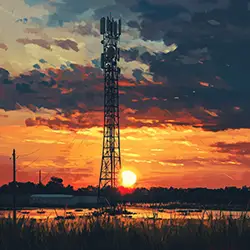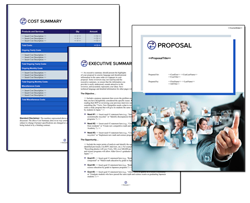
How to Write a Telecommunications Business Proposal: Best Practices and Examples
How do you write a telecommunications business proposal that wins contracts by offering best-in-class solutions? This guide explains the process step-by-step, covering essential chapters like the executive summary, problem statement, and designing a tailor-made solution.
Key Takeaways
- Understanding and using key chapters of a telecommunications business proposal-such as the executive summary, market analysis, and financial projections-is vital for successfully persuading potential clients and investors.
- Personalization and a clear problem statement that answers the client's specific needs and client requirements are crucial in demonstrating capability and building trust, ultimately increasing the chances of proposal acceptance.
- Incorporating client testimonials, case studies, service offerings, and a thorough quality control process ensures credibility and professionalism, essential for securing profitable contracts in the telecommunications industry.
Understanding the Basics of a Telecommunications Business Proposal

A business proposal, or a sales proposal, is a document designed to convince a potential client that your solution is their best option for addressing a specific problem or need. This is especially significant in the telecommunications industry, where an effective business proposal can make all the difference in providing complex and tailored telecommunications solutions to specific client requirements.
Sometimes, proposals are written to pitch internal company projects, fund a telecom startup business, or respond to a government RFP. Every type of proposal requires a different approach, all of which can be accomplished with the Proposal Kit. This article will touch on various aspects of these types of proposals.
Business proposals are used to present complex solutions and secure profitable contracts. In the telecommunications industry, where technology and client needs constantly evolve, a well-written, winning business proposal can set you apart from the competition and establish your company as a trusted partner. Reviewing business proposal examples and exploring various business proposal ideas specifically tailored to the telecommunications industry can help you better understand how to create a compelling proposal.
Business proposals can be either solicited or unsolicited. A solicited business proposal is one that a company has specifically requested from you for their consideration. It's a formal document presenting your ideas and solutions to fulfill their needs. On the other hand, unsolicited business proposals are sent to a prospective client who has yet to ask for one but is based on a market opportunity. Understanding the nature of your proposal is vital as it shapes the framework and strategy you adopt, ensuring your service offerings are well-aligned with client expectations.
Solicited proposals, such as responding to RFPs, usually have instructions that need to be followed, which may include specific requirements for the proposal. This is especially true for government RFPs.
Critical components of a winning business proposal for the telecommunications industry include:
- Executive summary
- Product or service description
- Market analysis
- Marketing strategy
- Financial analysis and costs
- Conclusion and call to action
Using business proposal templates can be a great way to ensure that your proposal covers all these key components. Proposal Kit templates include thousands of chapters to cover every topic needed in a comprehensive telecom proposal.
Each chapter conveys your message and demonstrates the value you can provide. It is also important to adhere to a standard format while ensuring your proposal appears professional and cohesive.
Business proposals are typically edited using a word processor and automated assembly and customization software such as Proposal Kit. This makes personalizing each proposal for the specific client easier. Personalization shows that you have taken the time to understand the client's unique needs and challenges, increasing the chances of your proposal being accepted.
Creating an Executive Summary for a Business Proposal

The executive summary serves as the foundation of your business proposal, offering a condensed overview that captivates the reader immediately by addressing client requirements and showing your understanding of their needs. The purpose of an executive summary is to introduce and summarize the business plan, capture the reader's attention, and emphasize the importance of the proposal.
To create a winning executive summary, you should include things such as:
- The mission statement
- Target market
- Competitive advantage
- Service offerings and pricing
- Financial goals
This section should provide a holistic overview of the proposal, explaining how it addresses the client's problem and expected outcomes. A well-written executive summary can make a lasting impression and set the tone for the rest of your proposal.
Structure your executive summary to maximize impact. Start by introducing high-level ideas and focusing on the client's company. This shows that you have done your homework and understand their specific needs. Next, briefly outline your project management implementation plan, including estimated person-days and coordination details. This gives the client a clear picture of how you plan to execute the project.
Conclude the executive summary by restating the main selling points and emphasizing your company's positive financial impact and trustworthiness. The executive summary should be concise, ideally summarizing the proposal in 1-2 pages. This ensures that even if the reader only goes through part of the document, they still understand your value proposition clearly. The executive summary may often be the only page a high-level executive reads before passing the proposal to their team to work through the details.
Defining the Problem Statement
A precise and explicit problem statement is critical in a telecommunications business proposal. It signifies a complete understanding of the client's requirements, needs, and problems.
The problem statement should articulate the client's specific needs or challenges. This involves conducting thorough research and critical thinking to understand the particular issues your client is facing. Clearly defining the problem or need your proposal addresses lays the groundwork for presenting a tailored solution.
Proposing a Tailored Solution

Upon defining the problem statement, the next step involves suggesting a custom solution that highlights your service offerings. Customizing your proposed solution to the client's needs is crucial to making your business proposal stand out. Frame the client's problems in a way that sets up your solution as the best choice. This involves elaborating on how your solution specifically tackles the client's problem or need. You position your company as the ideal partner to address their challenges by doing so.
Include details about the deliverables you will provide, the methods you will use, and a time frame for the proposed solution. This will give the client a clear understanding of what to expect and when adding to the credibility of your proposal. Being transparent about the process also helps build trust with the client.
Transition smoothly to the next section by highlighting how your company's expertise and experience make you the best fit to deliver the proposed solution. This sets the stage for showcasing your company's credentials and past successes.
Showcasing Your Expertise and Experience
Underlining your company's proficiency and experience is necessary to foster trust and credibility with prospective clients. This section should showcase your company's history, industry expertise, and past successes in meeting client requirements. Discussing your company's history, including headquarters location and employee count, can provide context but should be concise. Focus more on your industry expertise and past similar projects to grab the reader's interest. This shows you have a proven track record of success in telecommunications.
Showcasing past successes and relevant experience builds trust and credibility. Include success stories and specific credentials demonstrating your ability to meet client needs. Highlighting your company's unique selling proposition can explain why investors should back your venture.
Use charts and graphs to illustrate your expertise and past project outcomes. This makes the information more digestible and adds a professional touch to your proposal.
Detailing Your Products and Services
A business proposal must portray your products and services. This section should emphasize your offerings' benefits and competitive advantages.
Describe your products and services, including trademarks, copyrights, and associated patents. Highlighting such unique features can set your proposal apart.
Emphasize your competitive advantages and unique selling points. Outline key features that set your solution apart from other systems in the market.
Describe the benefits of your products or services, including key customers and partners, and explain how they address potential clients' needs. Including details about future products and services can also provide a comprehensive view of what you can offer.
Conducting a Thorough Market Analysis

A comprehensive market analysis shows an understanding of the market trends and environment in which your telecommunications business functions. This section demonstrates value to investors and can offer insights for effective marketing strategies.
Start by analyzing industry trends to understand potential opportunities and threats. This involves gathering data on the telecommunications industry's size, growth, demand, and challenges. Such data points provide a solid foundation for your analysis.
Identify target market characteristics and industry trends to demonstrate business viability to investors. This includes understanding customer demographics, purchase habits, and pain points. A detailed breakdown of these factors can help you tailor your marketing strategies effectively.
Competitor analysis is another vital aspect of market analysis. This involves evaluating competitors:
- strengths
- weaknesses
- products
- pricing
- marketing
- distribution strategies
Highlighting opportunities and gaps in competitors' offerings can help position your company favorably in the market.
Address market entry barriers such as high capital requirements or strong competitor presence. Demonstrating how your company plans to overcome these barriers can instill confidence in potential investors and partners. A comprehensive market analysis determines your company's position in the market and guides the development of effective marketing strategies.
Here are some related samples included in every downloadable Proposal Pack
- IT Product and Service Sales Proposal
- Technology Consulting Sample Proposal
- Software Automation Sample Proposal
- Process Improvement Sample Proposal
- Training Services Sample Proposal
- Software and Hardware System Sample Proposal
- Network Cabling Sample Proposal
- Patenting New Technology Sample Proposal
- Call Center Startup Funding Sample Proposal
Here are some related downloadable templates
Developing a Strategic Marketing Plan
Formulating a marketing plan that aligns with market trends is vital for effectively promoting your telecom services. This section should outline:
- Your marketing objectives
- Your marketing strategies
- Your pricing strategy
- Your marketing channels
- Your budget allocation

Start by defining your marketing objectives, such as communicating your unique value proposition, building trust and credibility, and generating leads and referrals. Clear objectives provide direction and focus for your marketing efforts.
Integrate a combination of different marketing elements to ensure comprehensive growth. This encompasses advertising, promotional literature, and public relations, all essential components of a comprehensive marketing strategy. Specific channels such as radio, print advertising, trade shows, and social media can be used to reach your target market effectively. For instance, a social media marketing proposal can be a powerful tool for engaging prospective clients.
Budget allocation for sales and marketing is crucial for planning. Proper budget considerations ensure the effective implementation of marketing activities. Outline your budget clearly, detailing how funds will be allocated across different marketing channels.
Establish mechanisms for evaluating the success of your marketing efforts. This includes setting key performance indicators (KPIs) and creating a checklist for actionable tasks. Regularly assessing and adapting your marketing plan based on performance metrics ensures that your strategies remain effective and aligned with your business goals.
Financial Projections and Analysis
Precise financial forecasts are essential for predicting future performance, controlling cash flow, and strategizing for expansion. This section provides potential investors with a clear picture of your telecommunications business's economic viability.
Financial projections include financial statements that forecast future revenue and expenses. These projections are beneficial for:
- Internal planning
- Attracting investors
- Evaluating performance
- Making business decisions
Creating financial projections involves several steps, including:
- Sales projections
- Expense projections
- Balance sheet projections
- Income statement projections
- Cash flow projections
Each component plays a vital role in providing a comprehensive financial overview. The Proposal Kit software includes customizable line-item databases for all these financial pages. You can also create custom calculations and new databases for special purposes.
Projecting income, expenses, and cash flow helps in understanding the financial health of your business. For instance, the financial plan for a telecommunications business proposal should outline project income and expenses for 3-5 years, including:
- Income statement
- Cash flow statement
- Balance sheet
- Break-even analysis
A balance sheet projection clearly shows your business's financial position concerning assets, liabilities, and equity. An income statement projection estimates your business's net income after accounting for all expenses. A cash flow projection forecasts the movement of all money to and from your company, providing insight into its liquidity. Demonstrating potential return on investment is crucial for attracting investors. These types of pages are going to be used in business plan funding and investing proposals.
Including Client Testimonials and Case Studies

Client testimonials and case studies are potent topics for establishing trust and credibility by addressing specific client requirements. This section demonstrates social proof by showcasing your past successes and satisfied customers. Social proof is crucial to establish credibility and build trust with prospects in a business proposal. Testimonials and case studies prove your company's capabilities and success.
Testimonials are statements from satisfied customers that can alleviate potential buyers' doubts. They often focus on the emotional aspects of the customer experience, such as how your product improved their life or exceeded their expectations. Ensure that the testimonials are authentic to avoid damaging credibility.
Case studies provide detailed accounts of how your product or service has helped a particular customer or business. Including direct quotes or testimonials in case studies can enhance their authenticity and credibility. Using these tools can significantly strengthen your business proposal.
Creating a Cover Page and Table of Contents
An aesthetically pleasing cover page and table of contents are vital for creating a favorable first impression and facilitating smooth navigation through your business proposal. Here are some tips to consider:
The cover page provides basic information about the document and sets the stage for the proposal. A professional design prominently displays the proposal title, basic introduction information, and the date.
Design your cover page using brand colors and logos to reflect your identity and create a harmonious look.
Use high-quality images that support your message and fit your theme.
Incorporate white space, borders, and dividers to create a clean and organized layout.
Including a table of contents in a business proposal might only sometimes be required, but its presence can facilitate the document's navigation and comprehension for all involved parties. A table of contents may be added once a proposal has around 8-10 pages. It allows for quick referencing and a clear understanding of the proposal's structure and contents. It provides a glance at critical sections and helps in easy navigation to relevant sections. Maintaining consistency in color scheme and fonts throughout the proposal is crucial. Tools like Proposal Kit can help you create a professional design and layout for your telecom proposals.
A professional cover page and table of contents should also introduce your service offerings, giving a clear overview of the proposal's scope.
Quality Control and Final Review
Implementing quality control measures and conducting a final review based on client requirements are significant steps toward guaranteeing an error-free proposal that upholds superior standards before submission. Proofreading every passage for errors is vital before sending the proposal to prospective clients. Quality control in a business proposal aims to ensure the proposal's success by checking for mistakes and maintaining quality.
If your company lacks the necessary staff for thorough proofreading, consider hiring a freelancer or bringing the required skillset onto the team. Involving all stakeholders in creating and executing a quality control plan fosters collaboration and builds alliances. Setting explicit product functionality and performance expectations in your quality control plan helps meet technical and quality standards. Performing quality control according to the established plan minimizes errors and reduces potential production delays.
A certified quality team will randomly assess sample products to ensure they meet specifications and functionality. Making necessary adjustments to the quality control plan to ensure product efficiency is critical for maintaining high quality.
 Proposal Kit Professional provides the most content, including legal contracts and a free design theme pack. Plus, advanced software features include custom branding and customizable quoting databases.
Proposal Kit Professional provides the most content, including legal contracts and a free design theme pack. Plus, advanced software features include custom branding and customizable quoting databases. Proposal Pack for Any Business covers this type of proposal and includes samples. There are also some commonly used specialty design themes available:
Proposal Pack for Any Business covers this type of proposal and includes samples. There are also some commonly used specialty design themes available:Photo Design Proposal Packs
Line Art Design Proposal Packs
 Proposal Pack Computers #1
Proposal Pack Computers #1 Proposal Pack Computers #2
Proposal Pack Computers #2 Proposal Pack Computers #3
Proposal Pack Computers #3 Proposal Pack Computers #4
Proposal Pack Computers #4 Proposal Pack Contemporary #6
Proposal Pack Contemporary #6 Proposal Pack Global #1
Proposal Pack Global #1 Proposal Pack Global #2
Proposal Pack Global #2 Proposal Pack Global #3
Proposal Pack Global #3 Proposal Pack In Motion #4
Proposal Pack In Motion #4 Proposal Pack Networks #1
Proposal Pack Networks #1 Proposal Pack Networks #2
Proposal Pack Networks #2 Proposal Pack Networks #3
Proposal Pack Networks #3 Proposal Pack Tech #1
Proposal Pack Tech #1 Proposal Pack Tech #3
Proposal Pack Tech #3 Proposal Pack Tech #4
Proposal Pack Tech #4 Proposal Pack Tech #5
Proposal Pack Tech #5 Proposal Pack Tech #6
Proposal Pack Tech #6 Proposal Pack Telecom #1
Proposal Pack Telecom #1 Proposal Pack Telecom #2
Proposal Pack Telecom #2 Proposal Pack Web #1
Proposal Pack Web #1 Proposal Pack Wireless #1
Proposal Pack Wireless #1 Proposal Pack Wireless #2
Proposal Pack Wireless #2 Proposal Pack Wireless #3
Proposal Pack Wireless #3
Summary

In summary, writing a telecommunications business proposal involves many critical components, each of which plays a vital role in persuading potential clients, investors, or stakeholders by showcasing your telecommunications solutions. Each section contributes to a comprehensive and persuasive proposal by understanding the basics, creating an engaging executive summary, detailing your products, services, or project pitch, and conducting a thorough analysis.
Following the best practices outlined in this guide, you can create a business proposal that stands out, addresses your client's specific needs, and demonstrates your company's expertise and value. Personalization, clarity, and professionalism are the keys to a winning proposal. Proposal Kit is designed to create any telecom proposal, from product and service sales to project pitches and business plan funding.
Frequently Asked Questions
What are the essential parts of a business proposal?
A business proposal typically includes an introduction, a description of needs and requirements, details of the project or goods/services, and information on the organization's expertise. These are the essential parts you need to include in your business proposal.
What should be included in the introduction of a business proposal?
In introducing a business proposal, include a cover letter introducing yourself, explaining your reason for sending the proposal, stating the desired action from the reader, and providing contact information. This will help to create a professional and well-structured beginning to your proposal.
Why is it essential to write a business proposal in the telecommunications industry?
Writing a business proposal in the telecommunications industry is essential to growing market share, securing project approvals, and establishing partnerships. It helps advance business objectives and foster growth.
What is the goal of a business proposal?
A business proposal aims to persuade the reader to agree with your ideas and sign off on a project or as a client.
How should a business proposal be customized?
A business proposal should be customized to specifically address how your products or services will fulfill the requirements of the potential customer or partner. Consider their needs and tailor your proposal accordingly. Your proposal must speak to the client or stakeholder first and foremost.



 Cart
Cart
 Are you just looking for a template, sample, or software for your telecom proposal? Click these links to skip down the page and get right to it.
Are you just looking for a template, sample, or software for your telecom proposal? Click these links to skip down the page and get right to it.









 Facebook
Facebook YouTube
YouTube X
X Search Site
Search Site